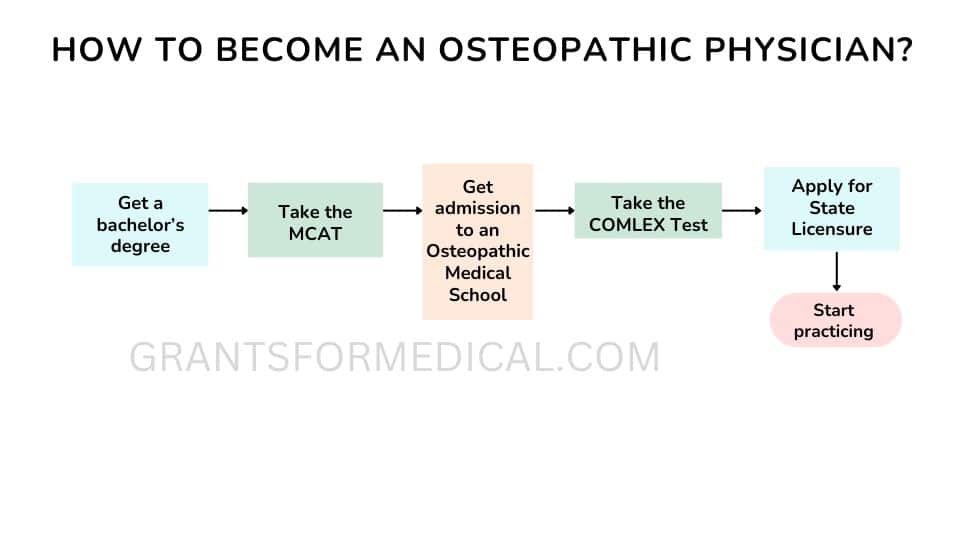How to Become an Osteopathic Physician – Overview
Osteopathic medicine has existed for over 120 years, and osteopathic physicians are some of the most prestigious doctors worldwide. The World Federation of Medical Education (WFME) does not directly accredit osteopathic medical schools, nor does its accreditation automatically grant DOs the right to practice worldwide, equivalent to MDs. Licensing requirements vary by country.
This article will be helpful if you want to learn how to become an osteopathic physician and get more information about the career.
What is Osteopathic Medicine?

Osteopathic medicine is an approach in healthcare and wellness that focuses on improving a person’s mental and physical health by treating their entire condition. This refers to changing or improving their lifestyle, diet, daily routine, exercises, and more.
The main difference between osteopathic and allopathic medicine is that the former focuses on treating the entire condition rather than focusing on individual symptoms.
Like a holistic nurse, a DO emphasizes tapping into the body’s self-healing ability and mitigates conventional allopathic medicines. Not only this, osteopathic medicine integrates numerous conventional medical practices but with a holistic approach through OMM (Osteopathic Manipulative Medicine), consisting of OMT and other techniques.
What is an Osteopathic Doctor?
A Doctor of Osteopathic Medicine (DO) is a licensed physician trained in an accredited osteopathic medical school. These professionals are educated in the osteopathic approach to healthcare, where patients are seen as partners during their medical treatment. As a DO, you will need to talk to patients about their conditions, lifestyle and other aspects that can imbalance the body’s function and structure.
A Doctor of Osteopathic Medicine performs duties that are similar to an MD, such as:
- Discussing the patient’s lifestyle and medical history
- Performing physical examinations of the patients
- Conducting or ordering diagnostic tests
- Interpreting diagnostic test results
- Making diagnoses and treatment plans to treat patient’s symptoms and health disorders
- Prescribing medicines or surgery as and when necessary
Osteopathic Manipulative Medicine (OMM) involves several types of manual techniques that can treat various problems that affect a person’s neuro-musculoskeletal system. Osteopathic physicians use hands-on, manipulative treatments called OMT (Osteopathic Manipulative Treatment) to optimize function and restore balance in the body.
Some of the most common OMT techniques used by DOs include:
- Lymphatic pump
- Soft stretching, kneading and massaging
- HVLA (High Velocity/Low Amplitude)
- Balanced ligamentous tension
Most techniques in OMT may seem similar to a chiropractor’s or a massage therapist’s.
7 Steps to Become an Osteopathic Physician
An aspiring osteopathic physician receives training in the same procedures and methods as an allopathic physician but in alternative natural healing. DOs lean OMT (Osteopathic Manipulative Treatment). It is a therapy that improves the body’s function and balance to self-heal.
If this sounds like a good career for you, then let’s check out how to become an osteopathic physician:
1 – Get a bachelor’s degree
One of the main criteria for getting into an osteopathic medical school is earning a bachelor’s degree in a science-related field. You will essentially have to earn specific numbers of credits in subjects like physics, biology, chemistry, or health sciences. Earning an undergraduate degree in these prerequisite courses is highly recommended if you want to become a DO.
2 – Take the MCAT
Like allopathic medical students, aspiring osteopathic physicians must also take the MCAT. This test evaluates a candidate’s understanding of social, natural, and behavioral sciences. Candidates must achieve the minimum passing score to get admission into an accredited school of osteopathic medicine.
3 – Get admission to an Osteopathic Medical School
Currently, there are 41 accredited schools of osteopathic medicine and 66 teaching locations approved by COCA (Commission on Osteopathic College Accreditation) in the US. (1) You should be ready for a four-year medical program to complete your studies. This period also includes clinical experiences besides the regular coursework.
4 – Take the COMLEX Test
The Comprehensive Osteopathic Medical Licensing Exam (COMLEX) is a three-part exam equivalent to the USMLE (United States Medical Licensing Exam) that every allopathic medical graduate must take to get a license for the practice.
Candidates must pass the first two parts of their exam to graduate from osteopathic medical school. The third part of the exam is held during your residency period. You will need to pass the COMLEX completely to apply for licensure.
5 – Apply for Residency/Fellowship
Once you have successfully passed parts one and two of COMLEX, you will need to apply for a residency, fellowship, or both to complete the required postgraduate training in osteopathic medicine. The state rules will specify the amount of postgraduate residency/fellowship training required to apply for licensure. According to the AOA (American Osteopathy Association), the residency period could be anywhere between 3 and 8 years.
6 –Apply for State Licensure
Upon successfully passing the COMLEX and completing your residency/fellowship, you must apply for an osteopathic license in your state. Check your state’s specific requirements, as they vary from state to state. According to the AOA, osteopathic physicians should check out the Federation of State Medical Boards to see their directory of state license boards.
7 – Start practicing
After receiving your license, you are officially a DO (Doctor of Osteopathic Medicine) and can apply for a job at a hospital, community health clinic, doctor’s office, or other healthcare facility.
To advance your career even further, you can also get certified by the AOA or ABMS (American Board of Medical Specialties) in a specific medical specialty. This certification will increase your competency and earning potential, too.
What are the Average Salary and Career Outlook of an Osteopathic Physician?
According to the AOA, “the osteopathic medical profession added more than 7,300 DOs to the physician workforce in 2022″. (2) As the healthcare industry continues to expand and public awareness about holistic healthcare alternatives grows, demand for osteopathic physicians in the coming years is expected to increase substantially.
Conclusion
An osteopathic physician is similar to an MD but focuses on holistic natural healing by boosting the body’s self-healing ability. These trained and licensed medical professionals work in hospitals, clinics, and other healthcare facilities. The growing public awareness of holistic medicine is expected to prove incredibly fruitful for a career as an osteopathic physician in the United States.
See Also
How to Become a Pharmaceutical Scientist
